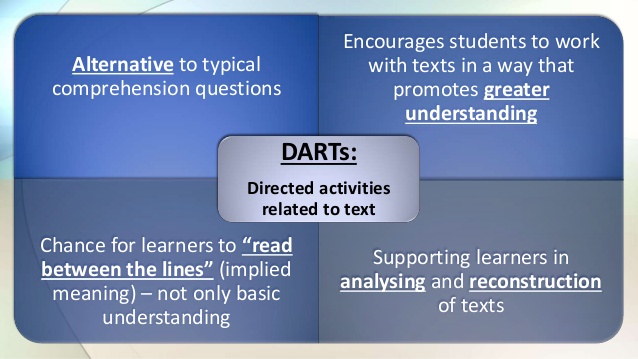Interacting with texts - Directed activities related to texts (DARTs)
Good readers use what they know about language and the world to interact with what they are reading. This helps them create meaning from the words on the page. Classroom activities that encourage interaction with texts, like directed activities related to texts (DARTs), improve students' reading comprehension.
What are directed activities related to texts (DARTs)?
DARTs are activities which get students to interact with texts. Their aim is to improve students' reading comprehension and to make them critical readers. They can be done by individual students or in groups
What type of activities can you use in DARTs?
DARTs can be divided into two groups: reconstruction activities and analysis activities:
What type of texts can you use in DARTs?
You can base a DART on traditional language texts like poems and extracts from short stories, novels and plays. You can also base them on extracts from magazines, newspapers, pamphlets etc, and passages from history, geography, science etc textbooks.
What are the advantages of using DARTs?
- When students interact with texts, their reading comprehension improves.
- They also become more aware of how texts are constructed.
- This makes them more critical of texts. They begin to ask questions about the information that has been included in, and excluded from, the text.
- And about the words and sentence constructions that the writer chose.
- As students' understanding of how text is constructed improves, so too does their own writing.
- Research has shown that interacting with texts also improves students' cognitive development.
- You don't need fancy equipment and resources to use DARTs. You can use textbooks from various subjects. Therefore, DARTs can be used in under-resourced schools.
- DARTs can make your students' textbooks more interesting.
- If you teach English is a context where English is the medium of instruction but it is not the students' first language, using DARTs based on passages from the students' textbooks will help prepare them for the texts they will encounter in other subjects.
- It will also help prepare them for the types of tasks they will encounter in other subjects. For example, filling in tables, labeling diagrams, completing Venn diagrams etc.
- DARTs also help students learn how to use texts without plagiarizing them.
And they help students learn how to produce their own graphic information like tables, flow charts, branch diagrams etc.
How can you develop your own DART?
Here is one method you could use:
- Once you have chosen the text, read it carefully. As you read, interact with the text. For example, underline or circle important information, write questions which you think the text raises or doesn't answer, list the main ideas and the supporting detail, draw a table or a diagram etc.
- Take note of how you interacted with the text. Did the text lend itself to a particular type of interaction. For example, it is often quite natural to develop a graphic organizer when we are reading and interacting with some types of texts. So...
| If the text | you may have developed | |
| compared and contrasted two or more things | a table or Venn diagram | |
| described a process | a flow chart. | |
| described a fictional or non-fictional sequence of events | a flow chart. | |
| described how something can be classified | a branch diagram. | |
| described an object | a labeled diagram.
|
|
| presented an argument | a spider diagram or mind map. |
Decide whether you want your students to do a reconstruction activity or an analysis activity.
- Use how you interacted with the text as a basis for your DART.
- For example, if you developed a flow chart while reading the text and you want your students to do a reconstruction activity, develop a relevant flow chart and then delete some of the information from the chart. Your students must fill in the missing information as they read. Write the instructions for the task.
- Or, if you developed a flow chart while reading the text and you want your students to do an analysis activity, write the instructions that will help them construct their own flow chart. There might be several steps in this activity. Firstly, you might ask your students to underline the steps in the process that is being described. Then you might ask them to draw a flow chart and fill this information in to it.







